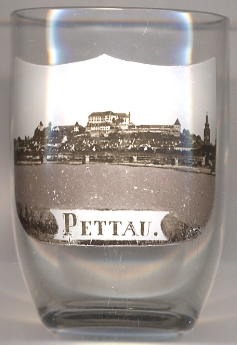

|
| SLOVENIJA | SLOVENIA |
| regija: Podravska |
Ptuj is situated at an elevation of 232 m on the river Drava in the (statistical) region Podravska of eastern Solovenia. the municipality has a population of about 24,000 (2008) and is one of eleven urban municipalities of Slovenia. Ptuj is the seat of the administrative unit Ptuj comprises the city of Ptuj and the municipaities Hajdina, Markovci, Gorišnica, Dornava, Kidričevo, Destrnik, Trnovska vas, Sveti Andraž v Slovenskih goricah, Juršinci, Videm, Zavrč, Podlehnik, Žetale and Majšperk.
Ptuj is the oldest city in Slovenia. There is evidence that the area was settled in the Stone Age. In the Late Iron Age it was settled by Celts. By the 1st century BC,
the settlement was controlled by Ancient Rome. In AD 69, Vespasian was elected Roman Emperor by the Danubian legions here, and the first written
mention of the city is from the same year. The city of Poetovio was the base-camp of Legio XIII Gemina in Pannonia. The name originated in the times of Emperor Trajan,
who granted the settlement city status and named it Colonia Ulpia Traiana Poetovio in 103. In 570 the city was occupied by Eurasian Avars and Slavic tribes.
Ptuj became part of the Frankish Empire after the fall of Avar state at the end of 8th century. Between 874 and 890 Ptuj gradually came under the influence of the
archbishopric of Salzburg; city rights passed in 1376 began an economic upswing for the settlement. As Pettau, it was incorporated into
the Duchy of Styria in 1555. Pettau was a battleground during the Ottoman wars in Europe and suffered from fires in 1684, 1705, 1710, and 1744.
Its population and importance began to decline in the 19th century, however, after the completion of the Vienna–Trieste
route of the Austrian Southern Railway, as the line went through Marburg (Maribor), Cilli (Celje) and
Laibach (Ljubljana) instead. According to the 1910 Austro-Hungarian census, 86% of the population of Pettau's Old Town was German-speaking,
 while the population of the surrounding villages predominantly spoke Slovene. After the collapse of Austria-Hungary at the end of World War I, Pettau was included
in the short-lived Republic of German Austria, but after the military intervention of the Slovenian general Rudolf Maister, the entire territory of Lower Styria was included
into the State of Slovenes, Croats and Serbs (Yugoslavia). During the interwar period, the number and the percentage of those identifying as Germans in the city, which was
renamed Ptuj, decreased rapidly, although a relatively strong ethnic German minority remained. After the invasion of Yugoslavia in April 1941, Ptuj was occupied by
Nazi Germany. From 1941 to 1944 the town's Slovenian population was dispossessed and deported. Their homes were taken over by German speakers from South Tyrol and the Gottschee
(Kočevje) county, who had themselves been evicted according to an agreement between Adolf Hitler and Benito Mussolini. These German immigrants,
along with the native German Pettauer, were expelled to Austria in 1945.
while the population of the surrounding villages predominantly spoke Slovene. After the collapse of Austria-Hungary at the end of World War I, Pettau was included
in the short-lived Republic of German Austria, but after the military intervention of the Slovenian general Rudolf Maister, the entire territory of Lower Styria was included
into the State of Slovenes, Croats and Serbs (Yugoslavia). During the interwar period, the number and the percentage of those identifying as Germans in the city, which was
renamed Ptuj, decreased rapidly, although a relatively strong ethnic German minority remained. After the invasion of Yugoslavia in April 1941, Ptuj was occupied by
Nazi Germany. From 1941 to 1944 the town's Slovenian population was dispossessed and deported. Their homes were taken over by German speakers from South Tyrol and the Gottschee
(Kočevje) county, who had themselves been evicted according to an agreement between Adolf Hitler and Benito Mussolini. These German immigrants,
along with the native German Pettauer, were expelled to Austria in 1945.
 Ptuj castle [centre background] is situated on a hill alongside the river Drava overlooking the town.
The castle was built in the mid-12th century, at the time when it was owned by the archbishopric of Salzburg, to defend against the Hungarians.
Ptuj castle [centre background] is situated on a hill alongside the river Drava overlooking the town.
The castle was built in the mid-12th century, at the time when it was owned by the archbishopric of Salzburg, to defend against the Hungarians.
 St. George's Church [far right] is one of the oldest churches in Slovenia.
The church was used as a pillory in the Middle Ages and was of major important to life in the town. Records indicate it was built around 1140.
The paintings, whose remains are on walls, were made from the late 13th to the end of the 15th century. In 1863 the church became Provost.
St. George's Church [far right] is one of the oldest churches in Slovenia.
The church was used as a pillory in the Middle Ages and was of major important to life in the town. Records indicate it was built around 1140.
The paintings, whose remains are on walls, were made from the late 13th to the end of the 15th century. In 1863 the church became Provost.
[https://de.wikipedia.org/wiki/Ptuj, https://en.wikipedia.org/wiki/Ptuj; https://en.wikipedia.org/wiki/Ptuj_Castle;
https://en.wikipedia.org/wiki/St._George's_Church,_Ptuj]
![[scale]](lineal.jpg)